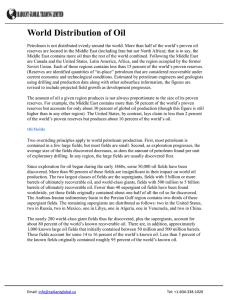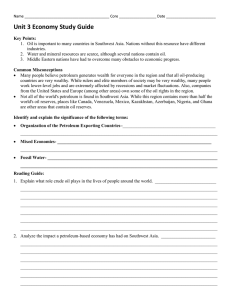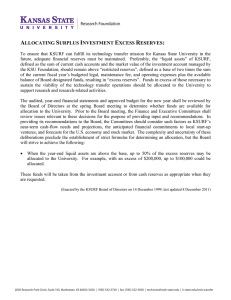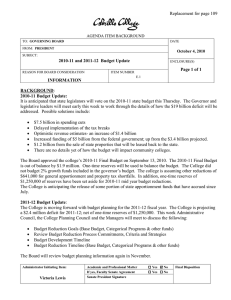Research Journal of Applied Sciences, Engineering and Technology 5(18): 4453-4457,... ISSN: 2040-7459; e-ISSN: 2040-7467
advertisement
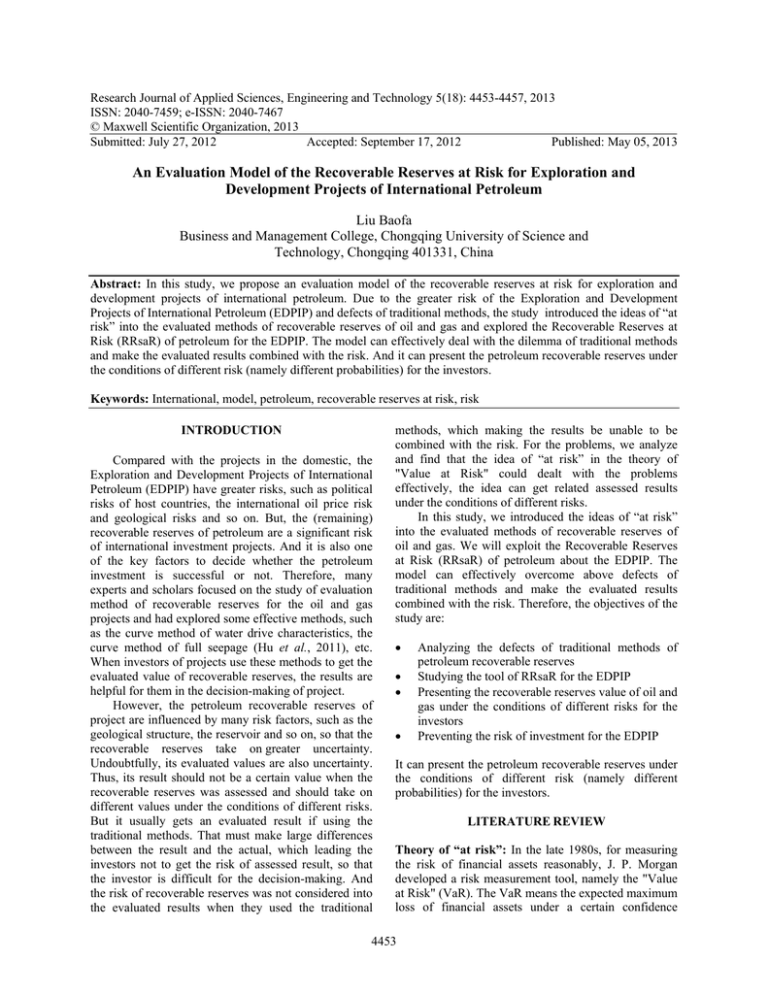
Research Journal of Applied Sciences, Engineering and Technology 5(18): 4453-4457, 2013 ISSN: 2040-7459; e-ISSN: 2040-7467 © Maxwell Scientific Organization, 2013 Submitted: July 27, 2012 Accepted: September 17, 2012 Published: May 05, 2013 An Evaluation Model of the Recoverable Reserves at Risk for Exploration and Development Projects of International Petroleum Liu Baofa Business and Management College, Chongqing University of Science and Technology, Chongqing 401331, China Abstract: In this study, we propose an evaluation model of the recoverable reserves at risk for exploration and development projects of international petroleum. Due to the greater risk of the Exploration and Development Projects of International Petroleum (EDPIP) and defects of traditional methods, the study introduced the ideas of “at risk” into the evaluated methods of recoverable reserves of oil and gas and explored the Recoverable Reserves at Risk (RRsaR) of petroleum for the EDPIP. The model can effectively deal with the dilemma of traditional methods and make the evaluated results combined with the risk. And it can present the petroleum recoverable reserves under the conditions of different risk (namely different probabilities) for the investors. Keywords: International, model, petroleum, recoverable reserves at risk, risk INTRODUCTION Compared with the projects in the domestic, the Exploration and Development Projects of International Petroleum (EDPIP) have greater risks, such as political risks of host countries, the international oil price risk and geological risks and so on. But, the (remaining) recoverable reserves of petroleum are a significant risk of international investment projects. And it is also one of the key factors to decide whether the petroleum investment is successful or not. Therefore, many experts and scholars focused on the study of evaluation method of recoverable reserves for the oil and gas projects and had explored some effective methods, such as the curve method of water drive characteristics, the curve method of full seepage (Hu et al., 2011), etc. When investors of projects use these methods to get the evaluated value of recoverable reserves, the results are helpful for them in the decision-making of project. However, the petroleum recoverable reserves of project are influenced by many risk factors, such as the geological structure, the reservoir and so on, so that the recoverable reserves take on greater uncertainty. Undoubtfully, its evaluated values are also uncertainty. Thus, its result should not be a certain value when the recoverable reserves was assessed and should take on different values under the conditions of different risks. But it usually gets an evaluated result if using the traditional methods. That must make large differences between the result and the actual, which leading the investors not to get the risk of assessed result, so that the investor is difficult for the decision-making. And the risk of recoverable reserves was not considered into the evaluated results when they used the traditional methods, which making the results be unable to be combined with the risk. For the problems, we analyze and find that the idea of “at risk” in the theory of "Value at Risk" could dealt with the problems effectively, the idea can get related assessed results under the conditions of different risks. In this study, we introduced the ideas of “at risk” into the evaluated methods of recoverable reserves of oil and gas. We will exploit the Recoverable Reserves at Risk (RRsaR) of petroleum about the EDPIP. The model can effectively overcome above defects of traditional methods and make the evaluated results combined with the risk. Therefore, the objectives of the study are: • • • • Analyzing the defects of traditional methods of petroleum recoverable reserves Studying the tool of RRsaR for the EDPIP Presenting the recoverable reserves value of oil and gas under the conditions of different risks for the investors Preventing the risk of investment for the EDPIP It can present the petroleum recoverable reserves under the conditions of different risk (namely different probabilities) for the investors. LITERATURE REVIEW Theory of “at risk”: In the late 1980s, for measuring the risk of financial assets reasonably, J. P. Morgan developed a risk measurement tool, namely the "Value at Risk" (VaR). The VaR means the expected maximum loss of financial assets under a certain confidence 4453 Res. J. Appl. Sci. Eng. Technol., 5(18): 4453-4457, 2013 within a period. Then, the tool won financial support widely and was researched and applied. For example, Duffie and Pan reviewed the VaR theory comprehensively (Duffle and Pan, 1997). Dowd recommended and studied the VaR models systematically (Dowd, 1998). Penza and Banasl described the application of VaR for the measuring market risk in detail (Penza and Bansal, 2001). Because it is effective for the application of VaR theory, the idea of "at risk" was gradually applied into non-financial fields and improved. Chen et al. (2000) and Li (2007) introduced the VaR into the risk management of project. Zhang et al. (2004) combined the Net Present Value with the VaR idea and developed the Project at Risk, then applying the method into the risk management of project. Hayt and Song (1995) proposed the Cash Flow at Risk (CFaR) in the processes of risk sensitivity analysis. Other authors advanced an improved VaR method, namely the Conditional Value at Risk (CVaR) (Zhi, 2005). Alesii (2005) introduced the VaR into real options, but he only analyzed the distribution of Net Cash Flows at Risk. • • Evaluated methods of petroleum recoverable reserves: For the evaluated methods of petroleum recoverable reserves, there are usually three Categories: the harvest methods, the geological methods, economic evaluation methods: • Harvest evaluation methods: For the harvest evaluation methods, there are some methods to assess the remaining recoverable reserves of petroleum, including the curve method of water drive characteristics (Lang, 1991), the curve method of full seepage (Shi, 2004), the curve method of dimensionless injection (Han, 2008), etc. The curve method of water drive characteristics applies to the petroleum deposit with high water proportion. The curve method of full seepage combined with the seepage curve and drive features curve and obtained the saturated water degree for the two-phase image area average. Then the method can get the remaining recoverable reserves of petroleum. It is effective if the information is more complete. The curve method of dimensionless injection is same as the curve method of water drive characteristics, but it assesses the remaining recoverable reserves fewer than 100% saturated water (Hu et al., 2011). These methods usually only obtain a value when they were used and in the evaluation, these methods didn’t relate to the risk of project. That make that evaluated results should be worse for the decisionmaking of investment. And the methods mainly applied to the invested projects, not suitable for the decision-making. Geological evaluation methods: For the geological evaluation methods of recoverable reserves of oil and gas, firstly it is to get the geological information. Then it calculates the recoverable reserves value of oil and gas by using the related tools, including the volumetric method, the method of petroliferous ratio, etc. But, how the method was applied, which is decided by the geological information and conditions of projects. If obtaining the information about the petroliferous saturated degree and the porosity degree, the volumetric method was used to evaluate the recoverable reserves of project. But if getting the date about the petroliferous ratio and rock density, the method of petroliferous ratio was applied (Wang et al., 2011). Compared with the harvest evaluation methods, the geological evaluation methods can be better used to the decision-making of investment projects. But the accuracy of their evaluation results rely on the information of project explored and they did not introduce the risk into the assessment of recoverable reserves. Economic evaluation methods: Although the harvest evaluation methods and geological methods can obtain the value of recoverable reserves, they don’t analyze the economic results of project, which being bad for the decision making. So, some scholars proposed the evaluation methods of economic recoverable reserves of oil and gas, such as remaining economic recoverable reserves (Ruan and Zhao, 2004; Shi and Fang, 2001; Guo, 2003). The method can provide the index which it is required the economic recoverable reserves of project and present the standard of decisionmaking for the petroleum project. However, the method only evaluates the minimum recoverable reserves based on the cost of project, not estimating the recoverable reserves and it did not also introduce the risk into the evaluation. That cannot present the recoverable reserves of project under different risk for investors. Therefore, if used in the EDPIP, there are some defects for the above methods. Because, for the EDPIP, it is necessary to properly evaluate not only its recoverable reserves, but also its risk. That is a dilemma for the traditional methods. Based on this, we introduce the ideas of “at Risk” into the assessment of petroleum recoverable reserves, then exploit the model of RRsaR. The model can effectively deal with the dilemma of traditional methods. It is helpful for investor to invest the EDPIP. MODEL OF RRsaR Currently, some assessment methods of reserves are volume, analogy and dynamic methods. The volume 4454 Res. J. Appl. Sci. Eng. Technol., 5(18): 4453-4457, 2013 Table 1: Geological information about some parameters for the EDPIP Parameters Unit Expected value Oil area A ac 1263 Oil reservoir thickness h ft 104.600 Degree of porosity Ф \ 0.250 Degree of saturated oil (1- S w ) \ 0.700 Average volume coefficient of oil formation B 0 \ 1.540 Ratio of oil recovery α \ 0.293 Jia (2004) method is the most commonly used in the evaluation of oil and gas reserves and it does not rely on the trend of oil well production. So, in the study, we adopt the method. By analyzing the literatures of oil and gas reserves of oil exploration project, we find that the total reserves are related to some factors, such as oil (gas) area, oil (gas) layer thickness, degree of porosity, degree of saturated water, volume parameter of reservoir, etc. But the key parameters are “reserves density, oil reservoir thickness, oil area, average degree of porosity and average degree of saturated water, average volume coefficient of oil and gas formation”. According to the achievement of geological research fields, we can get the distribution function of the total reserves quantities of oil project. Then the total reserves quantities of oil project: Q = 7758*h*A*Ф* (1-S w ) /B 0 (1) where, h = The oil reservoir thickness A = The area of oil Ф = Average degree of porosity S w = The average degree of saturated water B 0 = The average volume coefficient of oil formation The eventually harvested recovery quantity makes by multiplying the oil reserves and the recoverable ratio α. So, we can get the distribution function of planned recoverable quantities of project. Then: Q t = α*Q = α*7758*h*A*Ф* (1-S w ) /B 0 (2) where, α is the ratio of oil recovery and can be estimated according to the project actual situation, usually below 0.5. Generally, the parameters, including the oil reservoir thickness h and the oil area A satisfy the lognormal distributions, but some parameters satisfy the normal distributions, including the degree of porosity ф and the degree of saturated water S w . The distribution functions of other parameters, including α and B 0 , can get from the calculation and assessment of data gathered according to the exploration and logging. So, if the distribution functions of all parameters in the Eq. (2) were gotten, we can obtain the evaluation model of RRsaR for the EDPIP, then: Q aR = α *7758*h aR *A aR *Ф aR * (1-S w ) /B 0 (3) S.D. 219.600 26.550 0.020 0.050 \ \ Max. 2000 200 0.310 0.850 1.560 0.580 Min. 775 50 0.200 0.600 1.520 0.040 Types of distribution function Lognormal Lognormal Lognormal Normal Trigonometric Trigonometric Table 2: Analysis results of petroleum recoverable reserves Percentile (%) Recoverable reserves value (bbls) 0 3,436,486.79 10 15,177,979.89 20 20,280,427.27 30 24,386,869.53 40 28,647,832.75 50 32,936,292.51 60 36,901,513.15 70 42,146,577.82 80 48,979,349.50 90 59,327,538.45 100 127,255,845.77 Thus, we use the Monte Carlo simulation technology to get the petroleum recoverable reserves Q x under the conditions of different risk (namely different probabilities). Where, x is the confidence level (probability). That is that the petroleum recoverable reserves are Q under the confidence level x. If x = 95%, it is that the recoverable reserves is no less than Q under the probability 95%. Case study: There is an EDPIP, which drilled a discovery well in a simple three-sided plunge, a closed structures of fault control (Jia, 2004). Some data of its exploration are shown in the Table 1. Then we analyze the RRsaR according to the processes of RRsaR model. So, according to the Eq. (3), we get the model of petroleum recoverable reserves, namely the Eq. (5): Q aR = α*7758*h aR *A aR *Ф aR * (1-S w ) /B 0 (4) Then, according to the Table 1, distribution functions of all parameters are obtained in the Eq. (4). So, we use the Crystal Ball software (Monte Carlo technology) to analyze the recoverable reserves QaR, the results being shown in the Table 2, Fig. 1. From the Table 2, we get the recoverable reserves values of the EDPIP under different probabilities, such as Q90% = 15,177,979.89 bbls. That is that the quantities of petroleum recoverable reserves are no less than 15,177,979.89 bbls under the probability 90%. DISCUSSION AND CONCLUSION Because there are the greater risk of EDPIP and defects of traditional methods, the study introduced the ideas of “at risk” into the evaluated methods of recoverable reserves of oil and gas and explored the Recoverable Reserves at Risk (RRsaR) of petroleum for 4455 Res. J. Appl. Sci. Eng. Technol., 5(18): 4453-4457, 2013 Table 3: Analysis results about distribution functions of petroleum recoverable reserves Distribution Parameters Parameter value Gamma Loc. 1579196.40 Scale 9661540.39 Shape 3.53 Test Chi square K-S test A-D test Test value 0.9461 (p-value) 0.0137 0.3419 Over l ay Char t Fr equency Compar i son .026 Gamma Distribution Loc. = 1,579,196.40 Scale = 9,661,540.39 Shape = 3.53 .019 .013 .006 Q .000 0.00 22,500,000.00 45,000,000.00 67,500,000.00 90,000,000.00 Fig. 1: Fitting status of gamma distribution of petroleum recoverable reserves the EDPIP. The model can effectively deal with the dilemma of traditional methods and make the evaluated results combined with the risk. It can also present the petroleum recoverable reserves under the conditions of different risk (namely different probabilities) for the investors, which being helpful for them to do the decision-making of EDPIP investment. In addition, for integrally analyzing the petroleum recoverable reserves, we discuss its distribution function. Then, we use the Crystal Ball software to simulate the Q aR 3,000 times according to the Eq. (5) and get the data of 3,000 Q aR . Further, we analyze the Q aR distribution function and the result is shown in the Table 3, Fig. 1. From the Table 3, we find that the Q aR distribution satisfies Gamma distribution (It is close fitting if Chi square test p-value is greater than 0.5. It is good fitting if K-S test value is less than 0.03. It is good fitting if A-D test value is less than 1.5) and other distribution types are not superior to the distribution. So, using the distribution function of Q aR , the investor can know more information about the risk of project. ACKNOWLEDGMENT The authors are grateful for financial support from the Social Science Program Fund of Ministry of Education of the People’s Republic of China (No. 11YJA630059), the Key Projects of Philosophy and Social Sciences Research of Ministry of Education of the People’s Republic of China (No. 09JZD0038) and Social Science Program Fund of Chongqing Board of Education (No. 12SKQ03). REFERENCES Alesii, G., 2005. VaR in real options analysis. Rev. Financ. Econ., 14: 189-208. Chen, D., Y. Lin, Y. Lu and S. Wu, 2000. Bot projects in Taiwan: Financial modelling risk, term structure of net cash flows and project at risk analysis. J. Struct. Proj. Financ., 5(4): 53-63. Dowd, K., 1998. Beyond Value-at-Risk: The New Science of Risk Management. John Wiley and Sons, New York. Duffle, D. and J. Pan, 1997. An overview of value at risk. J. Deriv., 4(3):7-49. Guo, Q.J., 2003. The brief introduction of method of reserves evaluation of remaining economic recoverable oil and gas. Nat. Gas. Geosci. China, 4(6): 525-528. Han, S.J., 2008. Quantitative Description Method and its Application of Water Drive Remaining Reserves in the Period of High Saturated Water on the Land. China Petroleum University Press, Dongying, China. Hayt, G. and S. Song, 1995. Handle with sensitivity. Risk Mag., 8(9): 94-99 Hu, Y.W., G.M. Yu, M.X.Y. Jiang, J. Yan and J. Chen, 2011. A Study of remaining recoverable reserves of conventional heavy oil reservoir. J. Oil. Gas. Technol., 32(6): 468-470. Jia, C.Z., 2004. Evaluation Methods of Oil and Gas Reserves about American SEC. Petroleum Industry Press, Beijing, China, 8: 86-90. Lang, Z.X., 1991. Reservoir Engineering Foundation. Petroleum Press, Dongying. Li, H., 2007. An application of VaR in risk management of project. J. Dongbei. Uni. Financ. Econ. China, 7: 21-23. Penza, P. and V.K. Bansal, 2001. Measuring Market Risk with Value at Risk. John Wiley and Sons, New York. 4456 Res. J. Appl. Sci. Eng. Technol., 5(18): 4453-4457, 2013 Ruan, Q.Y. and Q.F. Zhao, 2004. A calculation method of remaining economic recoverable reserves: A study of NPV model. Fault-Bloch Oil and Gas Field, 11(1): 40-43. Shi, X.P., 2004. Quantitative Description Technology of Remaining Oil Distribution in the period of higher saturated water. Petrol. Chem. Inner Mongolia, 30(1): 14-15. Shi, Q.X. and K.P. Fang, 2001. The calculating method and application of economic limiting steam/oil ratio for steam flood and steam soak. Petrol. Expl. Dev., 28(4): 97-98. Wang S., J. Zhang and T. Zhong, 2011. Controlling factors and reserve calculation area in the northwest edge of oil sands reservoirs in Hongshanzui of the Dzungarian basin. China Min. Mag., 20(11): 53-56. Zhang, M., Y. Tu and W. Wang, 2004. PaR: A new method of risk management of large-scale project. J. Shanghai Jiaotong Univ., 3: 445-449, 454, China. Zhi, L., 2005. An application of VaR and CVaR in the risk management of venture capital investment. St. Expl. China, 5: 175-187. 4457
